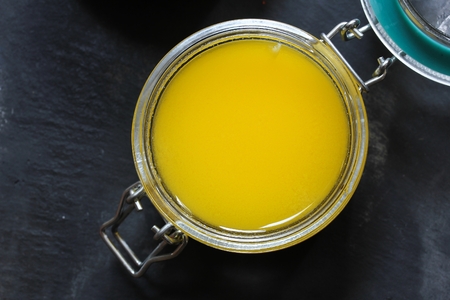Ghee - Clarified Butter

Common Names: Clarified butter, Ghee, Ghí, Indian ghee, Purified butter, Butterschmalz, Schmalzbutter, Geclarifiseerde boter, Bratbutter, Mantequilla clarificada, Boterolie, Le beurre clarifié, Subag, Samna baladi, Manteiga-de-garrafa, Maslo klarowane
Origin: Africa, Asia, Europe, South America, North America
Short Introduction
Ghee is made by gently simmering butter for 10–25 minutes until a clear layer forms on the surface of the liquid butter. The crust is removed, the golden liquid is separated from the rest, and the sediment that forms at the bottom is also discarded. Properly prepared ghee does not need to be refrigerated. It is believed that storing ghee at room temperature preserves more of its beneficial properties, and the longer it is stored, the more favorable its effect on the human body becomes.
Detailed Description
The Ayurvedic marvel—Ghee!
Botanical Information
Ghee is not of plant origin. The base ingredient is cow's milk.
Origin and Distribution
Ghee's popularity extends far beyond its original region. Ghee most likely originates from the Indian subcontinent, although its present popularity has spread across Europe and the Americas. Clarified butters have been traditionally produced on almost all continents, albeit under different names.
Usage / Dosage
Many cultures outside the Indian subcontinent make ghee, though they may call it by different names. Egyptians make a product called samna baladi, closely resembling Indian ghee in preparation and composition. Various ethnic groups in the Horn of Africa and North Africa prepare and use ghee with added garlic or other spices. In Somalia, clarified butter is called subag and is traditionally served for breakfast. A similar product in Northeastern Brazil is known as manteiga-de-garrafa. In Europe, ghee is very popular; for example, traditional schnitzel in Germany is cooked in ghee. Likewise, on the Swiss border, ghee is used for frying (e.g., in rösti). M.D. Rettigová, a Czech culinary authority, also knew and used traditional clarified butter.
All clarified butters are made by slowly simmering butter to gradually remove water and other residues until a clear fat appears. This fat has a higher smoke point (up to 252°C/485°F) compared to regular butter (maximum 190°C/374°F) and has a significantly longer shelf-life. Clarified butter can be stored outside the refrigerator and will last for months! Ghee contains negligible amounts of lactose and casein, making it suitable for most lactose-intolerant and milk-allergic individuals.
Ghee can be used for cooking and baking. Its advantages include high heat resistance, a mildly sweet and delicately nutty flavor and aroma. Ghee has traditionally been used in ceremonial occasions including weddings, funerals, and other rituals. It is also used in religious offerings and for spiritual purification. Ghee is a frequent ingredient in Indian cuisine, such as baati, roti, khichdi, or as an accompaniment like naan, depending on time and place of preparation. It's also used to make traditional Indian sweets and desserts (mysore pak, halva, laddu, etc.).
According to the Journal of Lipid Research (1993), consuming butter can increase cholesterol by 5% in men. A more recent study in the European Journal of Clinical Nutrition found that women who avoided milk fat from butter but consumed cheese had lower cholesterol levels. It has also been published that while regular butter raises plasma cholesterol, ghee—with regular consumption—notably reduces high cholesterol levels. Research described in the Journal of Nutritional Biochemistry confirmed this with animal and human volunteer studies. Additional in vivo studies have shown that regular consumption of ghee reduces LDL cholesterol, lowers triglycerides, and increases good (HDL) cholesterol. After a period of reducing ghee intake, these effects reversed. Therefore, ghee is highly likely to help in the prevention of heart disease.
Moreover, ghee supports detoxification by binding and neutralizing foreign substances in the body, while also stimulating metabolism to deal with these 'intruders.' In traditional Indian medicine (Ayurveda), ghee has been used for thousands of years to support vision, boost immune defenses, promote cell regeneration, and reduce fever. Regular doses are also given for chronic constipation and ulcerative diseases of the stomach and intestines.
Active Compounds
Like any other clarified or purified butter, ghee consists almost entirely of fat (99.5%). About 62% are saturated fats (in the USA, around 8 mg cholesterol per teaspoon), 29% monounsaturated fats, 4% polyunsaturated fats, about 4% trans fats, and minimal amounts of omega-3, 6, and 9 fatty acids. Ghee also contains cholesterol (about 250 mg per 100g of ghee), vitamin A, vitamin E, and vitamin K.
Traditional Dosage
There is no strict or defined dosage for ghee used in hot or cold dishes. When cooking, baking, frying, or spreading, moderation and balance are recommended to achieve a pleasant flavor.
